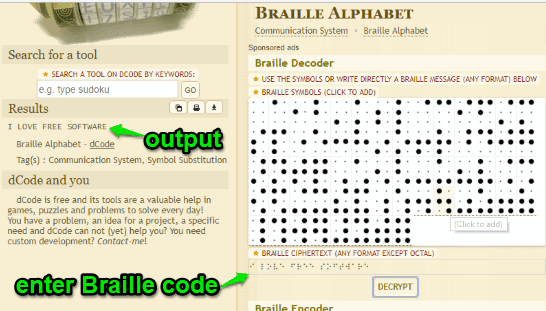

“We are aiming to make the device similar to a handheld scanner that allows the user to scan the entire page in one go.” The idea is to make it as easy as possible to operate, preventing the user from needing to keep track of where they are on the page. “Currently the camera only takes a picture of its field of view,” Chandani Doshi, one of the team members who is majoring in electrical engineering and computer science, explains via email. They have applied for a patent for the integration of the system through Microsoft’s #MakeWhatsNext patent program, which supports women inventors.
#Convert text to braille software
Then the team’s software translates each character into braille and subsequently triggers the mechanical system in the box to raise and lower the pins. Optical character recognition then takes over, identifying the characters on the page using Microsoft’s Computer Vision API. Users can place it down on a line of text and with a push of a button, the device takes an image. The team’s latest prototype, about the size of a candy bar, can display six characters at a time (the average English word is roughly five characters long) and has a built in camera. The title came with a $10,000 prize that they are hoping to put back into the project to continue to improve how the device works. “We were super honored to be chosen as one of the winners of the award,” says Wang. The winning inventions-a folding electric drone, proteins to fight superbugs, and a solar-powered desalination system for off-grid water production, to name a few-tackle a wide range of problems. Tactile is one of nine winners for this year’s Lemelson-MIT Student Prize, which celebrates the translation of “ideas into inventions that improve the world in which we live,” according to the contest’s website. Now, many prototypes later, the team has received another accolade. The win was just the beginning of their work with the device, which they dubbed Tactile. The first prototype they developed at the 2016 MakeMIT hackathon was rough, but it worked. But it worked, translating text to braille. It was slow and not particularly portable. It imaged each character of text using an external computer’s webcam, rather than an internal camera as the team had hoped, explains Chen “Bonnie” Wang, one of the team members who is currently a senior majoring in material science and engineering. Six pins poked up through the top of the device to display a single braille character (letter, number or punctuation mark). Nearly the size of an adult’s hand, the mechanics of the device were sandwiched between two panes of plastic-wires and circuit boards exposed.

It was something with potential to transform the lives of some of the 1.3 million Americans who are legally blind. Their idea: a portable, inexpensive device that could scan text and convert it to braille in real time. The women, competing under the team name 100% Enthusiasm, had set out to tackle a big challenge: accessibility for the blind. The team had just competed in MakeMIT’s hackathon-a competition in which teams of students spend 15 hours designing, coding, constructing, testing and debugging ambitious projects. Their table strewn with colorful wires, post it notes, food wrappers, scraps of papers, shapes cut from cardboard. In the wee hours of Valentine's day last year, a team of six women, all MIT engineering undergraduates, sat exhausted but exhilarated.


 0 kommentar(er)
0 kommentar(er)
